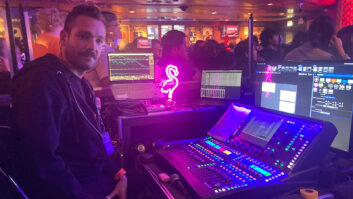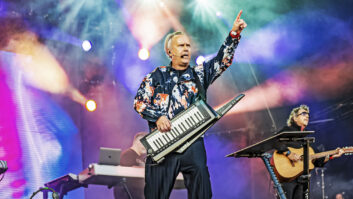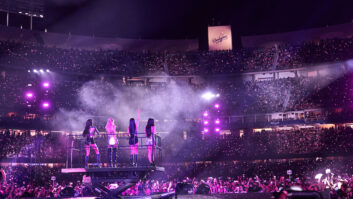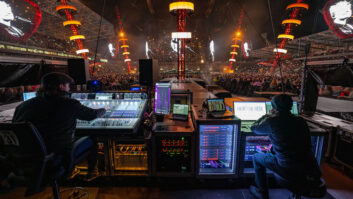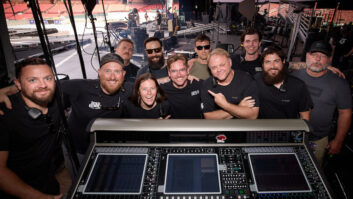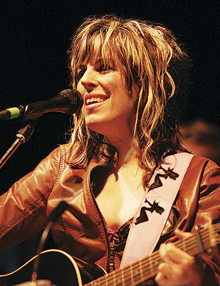
Photos by Steve Jennings

The pages of Mix are filled with talk of technology, but sometimes it pays to be simple. Keep it flat across the board, make sure the vocal cuts through and let the players play. A nip and tuck here, a notch out at 400 Hz, then give the band a good monitor mix, let them hear the house and they’ll begin to mix themselves.
At least that’s how it works when the lineup is Lucinda Williams opening for George Jones.
Last September, Jones called Williams and asked if she would open for him on a couple shows on the West Coast. She agreed, then decided to put together a last-minute small theater/club romp in and around the February dates with Jones. Rather than bring her four-piece band, however, Williams decided that her leg would be a duo — just her and ace guitarist Doug Pettibone. For the Oakland, Calif., and Santa Barbara, Calif., shows with Jones, however, she would fly in her rhythm section of bassist Taras Prodaniuk and drummer Jim Christie. Mix caught the Oakland show at the famed Paramount Theatre.
For the duo shows, which have garnered rave reviews across the West, Williams celebrated something of a return to her more simple singer/songwriter roots. She carried no production, save for a short rack containing the Avalon mic pre and BSS DPR-901 dynamic EQ, and she asked monitor engineer Mark Humphreys to pull double-duty at front of house.
Humphreys, a road veteran of Black Sabbath, Iron Maiden, The Smithereens and many others, has served as Neil Young’s monitor engineer since 1990 and as Williams’ for the past three years. Some of the lessons he learned with Young have been carried forward and incorporated into Williams’ show, including the emphasis on a clear vocal and a rather unique approach to stage monitoring.

George Jones
“My favorite word in the dictionary is ‘clarity,’” Humphreys says. “Working with Neil taught me that it’s all about getting the vocal out to everybody. Wherever you are — backstage, in the dressing room, at front of house — when that man is singing, that’s what you hear. And that’s the first thing I do with Lou is make sure you hear every bit. Then I work the guitar up, but no matter what she’s doing, you will always hear her.”
Because he’s hopping on a new system every night, Humphreys has seen his share of boards, big and small, and P.A.s of varying quality. So his soundcheck is fast and efficient. “I just make sure that from 1k to 6.3 can be heard anywhere in the room, and I try to aim the horns so everybody can hear the top end of the P.A. I don’t care that much about the low end, because once you create it, it just sweeps the room anyway. I like to run the system dead-flat, and any bad tonal frequencies — 125, 160, 315, 400 — I’ll take off the mic strip so I don’t create it onstage. Over the years, I’ve learned that if you lose the bottom out of your mic channels, it stops that in the room. Kind of backward, but it works for me.”
For the duo shows, Humphreys is using only eight channels on the board du jour. He splits those at the FOH console and does another eight as his foldback to the stage. Essentially, the musicians are getting the same mix as the audience, as Humphreys loads the sidefills with a full mix, placing the monitors downstage, pointed back, as if there is a “musicians’ P.A.” It’s a system he first worked up for Wasp, then incorporated into Young’s show and now uses with Williams. He adds in a wedge for each bandmember (vocal only), supplementing it with a tiny wedge off to Williams right that he feeds guitar-only. Humphreys points out that Williams loves the feel of the house, especially the old-school theaters she’s been playing, and will likely never go with in-ear monitoring.

Greg McGill, FOH for George Jones
Humphreys takes the same approach to the stage whether it’s the two guitarists or a full band, the only difference being that he actually gets to move up and have his own console, leaving FOH duties to San Francisco — based Nick Pellicciotto, who has been with Williams since her 2004 tour. Pellicciotto is the one who put together her vocal chain, which comprises an Audix OM6 microphone, Avalon mic pre, BSS DPR-901 dynamic EQ, back into an insert return on the console to avoid the channel preamps. At the Oakland show, Pellicciotto had a Yamaha PM5D at FOH, as did Humphreys at monitors. Like Humphreys, Pellicciotto does everything he can to keep things simple, with very little effects inserted.
“With a band of this quality, processing would kill whatever they’re doing,” Pellicciotto says. “I simply do whatever I can to stay out of the way, to be transparent. I see my role as a balance engineer, though I do work in effects at times. Lucinda has three types of songs. On the ballads, I may pull the kick and bass down a bit so the lows don’t wash stuff away. Then on the more bluesy or rootsy numbers, I may change the miking a bit and add some effects to make the drums sound a little more trashy, raucous and not too distinct. Same for guitars. And then the rock numbers get a pretty standard mix.

Nick Pellicciotto, FOH for Lucinda Williams
“I agree with Mark on the need for clarity in her vocal,” he continues, “but these systems have gotten so clean that I often find some murkiness can be helpful. Some graininess and lo-fi feel, especially on the bluesy numbers. And I never really sacrifice the band for her vocal. I’m for everything being audible. Doug [Pettibone] is so good at dealing with dynamics — if he’s too loud, he should be too loud. [Laughs] And the rhythm section is just a dream. I have no gates on the drums; they’re all open.”
While Williams has stripped back her production, Jones is carrying a full semi of gear, both sound and lighting, for this 19-city leg. The P.A. put up at the Paramount was put together by his longtime engineer Jimmy Owen of Owen Audio in Nashvillle. A few years back, Owen wanted to get off the road and turned the FOH reins over to Greg McGill (Merle Haggard, T.G. Sheppard, Lee Ann Womack).
“It’s a system of proprietary, refrigerator-looking boxes,” McGill explains as he points to the well-traveled cabs. “They each have a Gauss horn, two JBL Bullets and two JBL 15s. I carry 12, though we’re only using three each side tonight. The subs are folded-horn — type. The amps are all McIntosh 2200 and 2300 models, solid-state, and they sound really smooth with that older country feel. I think it sounds as good as some of the line arrays out there.”

Mark Humphreys, monitor engineer for Lucinda Williams
Though Jones had a sinus infection at the Oakland show and was not in top form, he’s still George Jones, with one of the most distinctive voices of the past century. He sings into an Audio-Technica Artist Elite AE4100 mic. McGill says, “I can get more headroom out of that mic. George will talk and then turn his head, but people come to hear everything he has to say. We do our best to give them that.” The only effect in the chain is a TC Electronic Intonator, which McGill inserts in the channel and blends back in, giving him a bit more presence in the top end. The entire band is on a Sennheiser in-ear system, which McGill says has dramatically helped the mix by eliminating stage volume and adding consistency night after night.
Like his Williams counterparts, McGill keeps everything simple, mixing the show “old-school — style.” Being simple doesn’t mean set and forget, however. Like Humphreys, he actively pans throughout the show to avoid layers and build-up, preferring to find a space for each instrument. Most members of the band have been with Jones 20 years or more, so the dynamics are all taken care of on the stage with the players.
As we went to press, Jones was wrapping up and Williams had a few dates left from Dallas to L.A. If you get a chance, check her out. Many have remarked that it’s the best-sounding show out there; one guy in San Diego even left a $50 tip on the console.
Tom Kenny is the editor of Mix.

For Lucinda Williams’ latest jaunt with George Williams, Williams asked monitor engineer Mark Humphreys to pull double-duty at front of house. For her 2004 tour, Williams relied on FOH engineer Nathan Harlow, a new addition to her touring crew. Check out what Harlow had to say for that tour.
